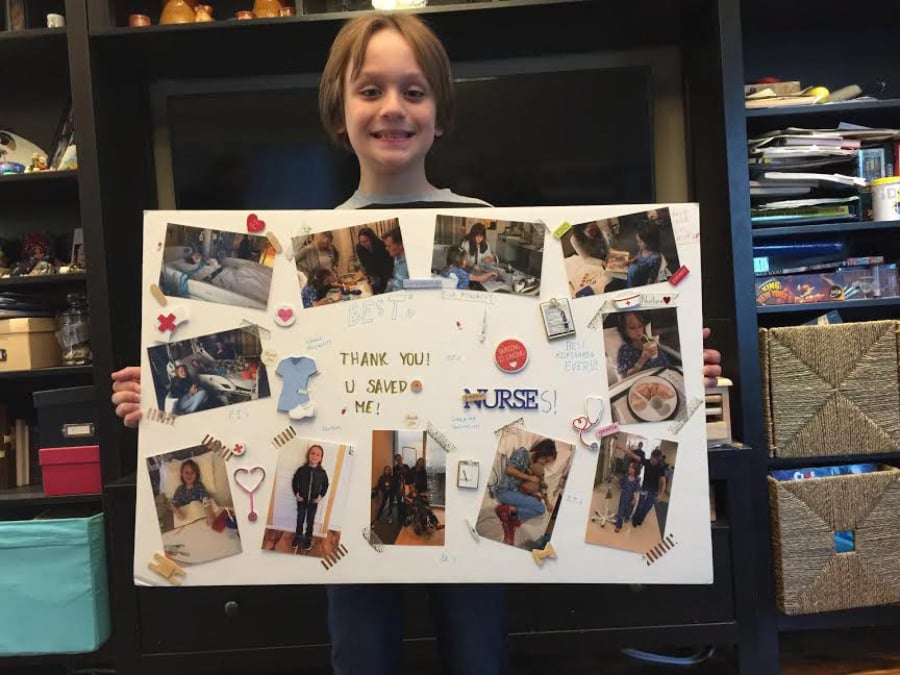Connor Kassing wouldn’t let his brain bleed stop him. He had a Lego set to finish.
His long story started during a physical education class in late January. Connor, 8, encountered the worst headache of his life. His dad, Steven Kassing, 44, came to pick him up from school. Kassing, a former paramedic, checked his son for head trauma, but didn’t find any.
But Connor fell asleep on the short car ride, and vomited when he got home. Steven and Connor’s mom, Mayte, 46, decided to let him nap. They thought he might have the flu or a stomach bug, but then Connor showed signs of hallucination in addition to vomiting and fatigue. His parents knew he needed to see a doctor.
“I asked him, ‘Where are you right now, Connor?’ ” his dad recalled. “He said, ‘I’m in the Empire State Building.’ And I look around, and I said, ‘Look around this room. Look around where you are,’ and he says, ‘Yup, Empire State Building.’ ”
That was the beginning of a medical journey that included a nearly two-week stay at Randall Children’s Hospital in Portland, where Connor played with Lego sets donated to the hospital, and was motivated to recover so he could complete his own “Star Wars” Lego set to win first place for Sci-fi Lego Display at Shahala Middle School’s Readcon event in March.
“I felt proud of myself,” Connor said of his placing. “I felt like I worked hard and that was worth it. I just felt happy and proud and that I should believe in myself more.”
Small steps of hope
After Connor started hallucinating about the Empire State Building, his parents took him to his pediatrician’s office on the PeaceHealth Southwest Medical Center campus. He was quickly rushed over to the PeaceHealth emergency room, where the brain bleed was discovered. He was then shuttled to Portland’s Randall Children’s Hospital in an ambulance.
What then followed was about an hour of waiting while doctors stopped his brain bleed, and put a drain in place. Connor spent most of the next two weeks in the pediatric intensive care unit.
“I was very much in work mode (as a former paramedic),” his dad said, but “there was a lot of emotion there for me, too. It was a charged environment because of the unknown, the risks. I didn’t know if he was going to come out of this. I didn’t know if he was going to be alive at the end of this. I didn’t know if he was going to have some mental and physical challenges we needed to address, and for a couple days it was a lot of waiting.”
The first 2 1/2 days in the PICU, Connor was sedated. But over the two weeks, Connor slowly started to become himself again. First he waved to his dad with his left hand. Then, later, he waved to his mom with the right hand. That showed his parents he had equal motor skills on both sides. Then he comprehended his parents’ Spanish — his mother is a native of Spain. The family adopted the motto “day by day, paso a paso,” which means day by day, step by step.
“Those little steps were very emotional because they gave us hope,” his mother said. “The brain is a mystery and you don’t know how it’s going to be affected.”
The child life department at Randall brought Legos to Connor once they discovered he was a fan of the toy.
Connor would sleep for much of the day, but when he woke up his parents tried to get him out of bed and playing with Legos. Therapists and an educator at the hospital watched as he played with the plastic bricks, seeing how his cognitive and physical function were recovering from his brain bleed. Before his brain bleed, Connor had signed up for the Lego competition at Shahala, choosing to construct a large “Star Wars” walker and diorama of the Battle of Crait from “The Last Jedi.” He was driven to recover, in part, by a desire to finish the competition.
“When he was at the hospital one of the things I kept telling him was, ‘Remember, you have this competition with your Legos. You need to get your Lego set ready, so you can participate,’ ” his mother said. “I think that motivated him a lot.”
The family said Legos were a good way to take their mind off Connor’s medical complications in the hospital and right after he left. Winning first place in a Lego competition meant even more to Connor after the hardship that preceded it, Connor said.
“It felt good to win first place because it felt good to know that after all that happened, I achieved something and I can still do what I love to do,” he said.
Doctors still don’t know exactly what caused the brain bleed, and Connor’s brain scans and tests don’t show any areas of concerns, but there is always a chance it could reoccur. For now, Connor has to avoid impacts or activities “that pose a risk of impact,” his dad said, for precautionary reasons. Connor said he now wants to collect Legos so he can donate them to Randall and pay it forward.
“What they did helped me, saved my life, really. Since they did that to me, I think it would be good to thank them and help the other kids who are in situations like that,” Connor said. “It could kind of make them feel good and have something fun to do, even in those rough times.”





